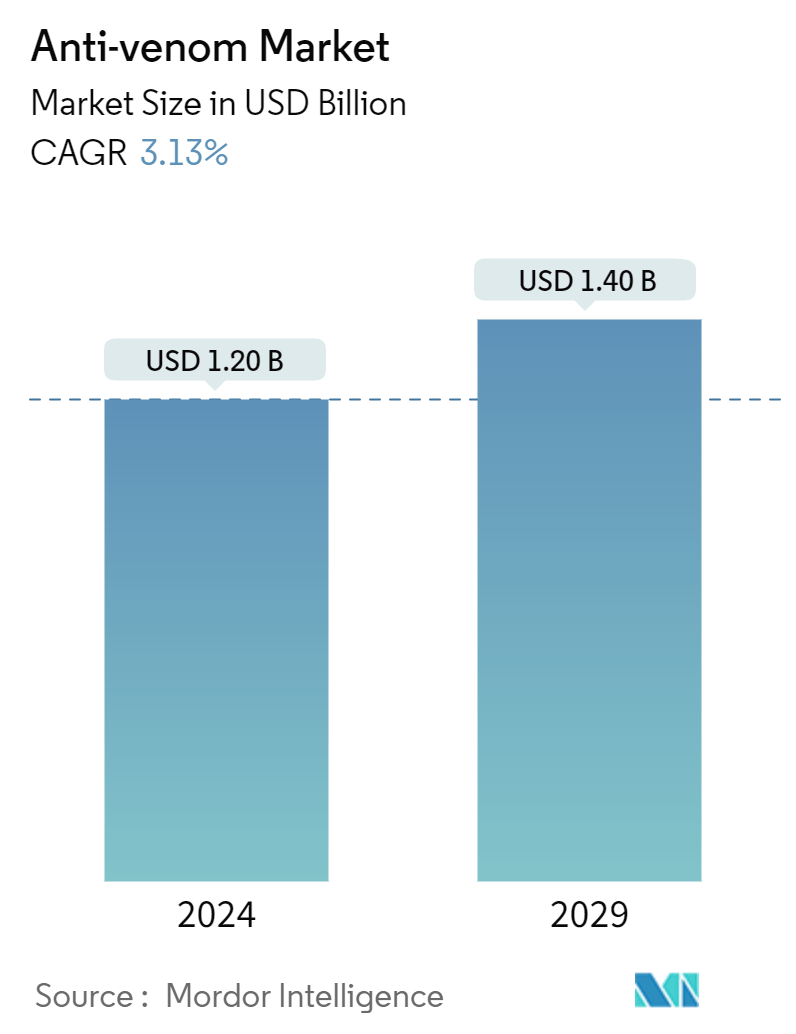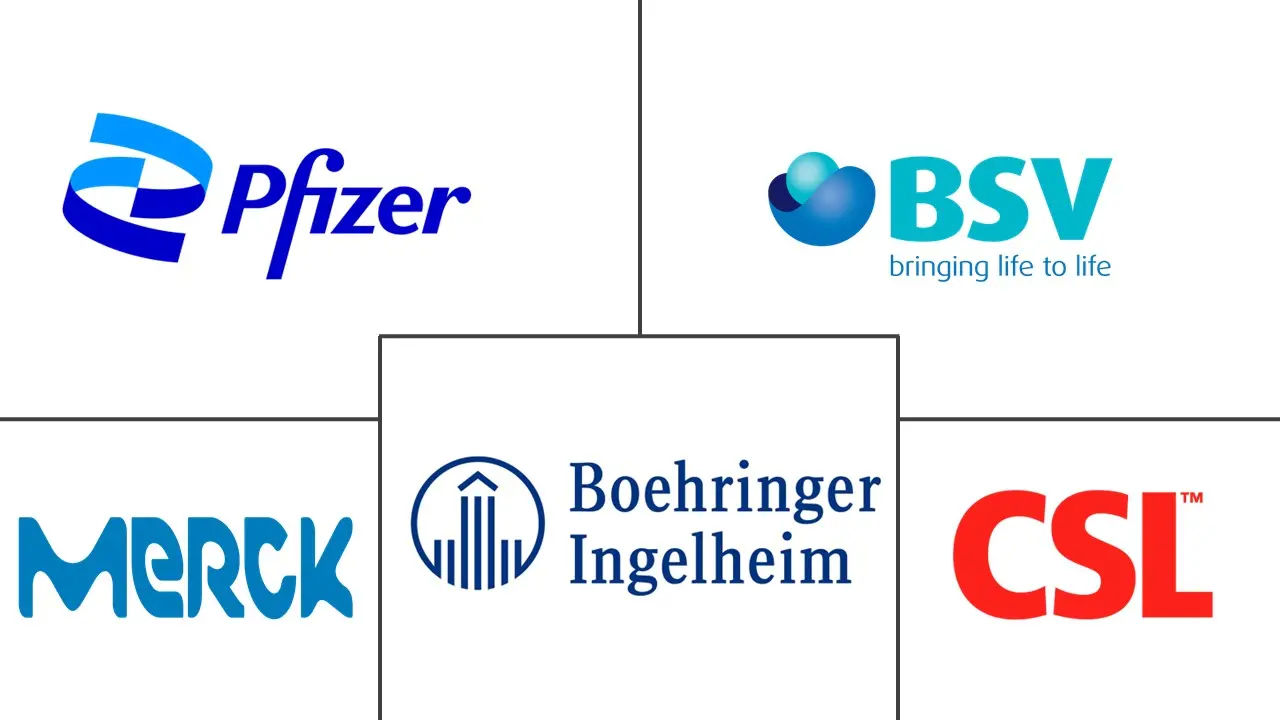Market Size of Anti-venom Industry

| Study Period | 2019 - 2029 |
| Market Size (2024) | USD 1.20 Billion |
| Market Size (2029) | USD 1.40 Billion |
| CAGR (2024 - 2029) | 3.13 % |
| Fastest Growing Market | Asia-Pacific |
| Largest Market | North America |
Major Players
*Disclaimer: Major Players sorted in no particular order |
Anti-Venom Market Analysis
The Anti-venom Market size is estimated at USD 1.20 billion in 2024, and is expected to reach USD 1.40 billion by 2029, growing at a CAGR of 3.13% during the forecast period (2024-2029).
During the COVID-19 epidemic, there was a considerable increase in the number of deaths reported from snake bites in a few regions. This caused a significant need for anti-venoms. However, shifting priorities due to the pandemic in already vulnerable health systems impacted snakebite care on all levels. According to the study published in the British Medical Journal in October 2021, after the COVID-19 pandemic was proclaimed in 2020, an estimated 2.7 million cases of snakebite envenoming (SBE) caused over 100,000 fatalities and 400,000 long-term impairments across Asia, Africa, and Latin America's poorest and most rural communities. Such studies greatly highlighted the treatment gap amid the outbreak. On the other hand, the market is expected to grow at a stable pace in the post-pandemic phase with the emerging strains of the SARS-CoV-2 virus worldwide. For instance, according to the study published by Cold Spring Herber Laboratory in January 2022, snake venom phospholipases A2 were found to have high virucidal activity against SARS-CoV-2 in vitro and to prevent cell fusion mediated by spike glycoprotein binding with the ACE2 receptor. Thus, as per the analysis, such instances are likely to augment the demand for anti-venoms among COVID-19 patients, in turn propelling the market's growth over the forecast period.
The studied market growth can largely be attributed to factors such as the increasing awareness of anti-venoms available in the market, the surge in cases of venomous bites, and technological advancements. Snakebite is one of the most neglected public health issues in many tropical and subtropical countries. According to the May 2021 update by the WHO, approximately 5.4 million snake bites occur each year, resulting in up to 2.7 million envenomings (poisonings from snake bites) and about 81,000 to 138,000 deaths. Moreover, it often leads to around three times as many amputations and other permanent disabilities. According to the August 2022 report "Accidental Deaths & Farm Suicides in India," 10,450 snakebite cases were reported in India in 2021, with 10,382 individuals dying and 64 injured. Furthermore, the data indicated that in 2021, Madhya Pradesh scored first in terms of snake bite deaths (2,732), followed by Odisha (1,019), Chhattisgarh (909), and Uttar Pradesh (844). Thus, the growing incidence of snake bites is expected to increase demand for anti-venom treatment, thereby boosting the growth of the market.
Furthermore, the prevalence of venomous bites and stings has increased over the years. To cater to the demand for anti-venom drugs, market players are opting for many initiatives to strengthen their market presence. For instance, in September 2021, a partnership between Papua New Guinea (PNG) and Australia to donate anti-venom and help save the lives of people bitten or stung by venomous snakes and marine creatures was extended for a further two years, 2021-2023. This will increase the accessibility of anti-venomous drugs across countries, thus driving the market growth.
However, anti-venom production is difficult and expensive. The cost of anti-venom has increased over the last two decades, making treatment unaffordable for most people. This is expected to hinder market growth over the forecast period.
Anti-Venom Industry Segmentation
As per the scope of the report, An anti-venom (or antivenin or antivenene) is a biological product used to treat venomous bites or stings. The anti-venom is created by extracting venom from the relevant species of animal, which includes snakes, spiders, insects, fish, etc. The Anti-venom Market is Segmented by Species (Snake, Scorpion, Spiders, and Other Species), Anti-venom Type (Polyvalent Anti-venoms, Monovalent Anti-venom, and Other Anti-venom Types), and Geography (North America, Europe, Asia-Pacific, Middle East and Africa, and South America). The market report also covers the estimated market sizes and trends for 17 countries across major regions globally. The report offers the market size and forecasts in value (USD million) for the above segments.
| By Species | |
| Snake | |
| Scorpion | |
| Spiders | |
| Other Species |
| By Anti-venom Type | |
| Polyvalent Anti-venoms | |
| Monovalent Anti-venom | |
| Other Anti-venom Types |
| Geography | ||||||||
| ||||||||
| ||||||||
| ||||||||
| ||||||||
|
Anti-venom Market Size Summary
The anti-venom market is poised for significant growth, driven by increasing awareness and technological advancements in the field. The market's expansion is largely attributed to the rising incidence of venomous bites, which remains a critical public health issue in tropical and subtropical regions. The COVID-19 pandemic highlighted the treatment gap for snakebite envenoming, as health systems shifted priorities, leading to a surge in demand for anti-venoms. Post-pandemic, the market is expected to benefit from the discovery of snake venom's potential antiviral properties against SARS-CoV-2, further propelling demand. The development of polyvalent anti-venoms, which can counteract multiple venoms, is gaining traction due to their effectiveness in regions with diverse venomous species. This focus on polyvalent solutions, coupled with ongoing research and development, is anticipated to accelerate market growth.
In North America, the anti-venom market is expected to hold a significant share, driven by a high incidence of venomous bites and increased awareness. The United States, in particular, is witnessing a rise in demand for anti-venom therapeutics, supported by strategic initiatives and product approvals from key market players. The competitive landscape of the anti-venom market is characterized by the presence of established manufacturers in countries like Brazil, India, and South Africa, which have local expertise and biotechnological facilities. Collaborative efforts, such as international agreements to improve antivenom production methodologies, are also contributing to market growth. Despite challenges like high production costs, the market is set to expand, supported by initiatives to enhance accessibility and affordability of anti-venom treatments.
Anti-venom Market Size - Table of Contents
-
1. MARKET DYNAMICS
-
1.1 Market Overview
-
1.2 Market Drivers
-
1.2.1 Increasing Awareness on Anti-venoms Available
-
1.2.2 Technological Advancements
-
-
1.3 Market Restraints
-
1.3.1 Complexities Involved in the Preparation of the Correct Immunogens
-
1.3.2 Lack of Regulatory Capacity for the Control of Anti-venoms in Countries
-
-
1.4 Porter's Five Forces Analysis
-
1.4.1 Threat of New Entrants
-
1.4.2 Bargaining Power of Buyers/Consumers
-
1.4.3 Bargaining Power of Suppliers
-
1.4.4 Threat of Substitute Products
-
1.4.5 Intensity of Competitive Rivalry
-
-
-
2. MARKET SEGMENTATION (Market Size by Value - in USD Million)
-
2.1 By Species
-
2.1.1 Snake
-
2.1.2 Scorpion
-
2.1.3 Spiders
-
2.1.4 Other Species
-
-
2.2 By Anti-venom Type
-
2.2.1 Polyvalent Anti-venoms
-
2.2.2 Monovalent Anti-venom
-
2.2.3 Other Anti-venom Types
-
-
2.3 Geography
-
2.3.1 North America
-
2.3.1.1 United States
-
2.3.1.2 Canada
-
2.3.1.3 Mexico
-
-
2.3.2 Europe
-
2.3.2.1 Germany
-
2.3.2.2 United Kingdom
-
2.3.2.3 France
-
2.3.2.4 Italy
-
2.3.2.5 Spain
-
2.3.2.6 Rest of Europe
-
-
2.3.3 Asia-Pacific
-
2.3.3.1 China
-
2.3.3.2 Japan
-
2.3.3.3 India
-
2.3.3.4 Australia
-
2.3.3.5 South Korea
-
2.3.3.6 Rest of Asia-Pacific
-
-
2.3.4 Middle East and Africa
-
2.3.4.1 GCC
-
2.3.4.2 South Africa
-
2.3.4.3 Rest of Middle East and Africa
-
-
2.3.5 South America
-
2.3.5.1 Brazil
-
2.3.5.2 Argentina
-
2.3.5.3 Rest of South America
-
-
-
Anti-venom Market Size FAQs
How big is the Anti-venom Market?
The Anti-venom Market size is expected to reach USD 1.20 billion in 2024 and grow at a CAGR of 3.13% to reach USD 1.40 billion by 2029.
What is the current Anti-venom Market size?
In 2024, the Anti-venom Market size is expected to reach USD 1.20 billion.

